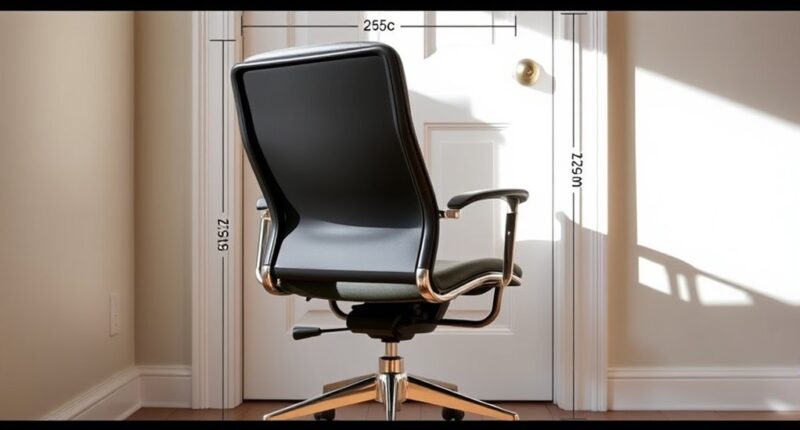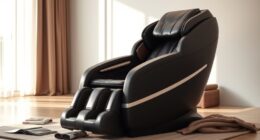To ensure safe and accessible passage, you need to take into account standard chair sizes, especially their width and height, and compare them with your doorway dimensions. Aim for doorways that are at least 32 inches wide for regular chairs and 36 inches for wider or wheelchair-accessible options. Measure accurately, check for obstacles, and consider tools or techniques to navigate tight spots smoothly. Keep safety in mind, and you’ll find out more on how to make your space easier to access.
Key Takeaways
- Ensure doorway widths are at least 32 inches for standard chairs and 36 inches for wheelchairs.
- Measure both width and height at multiple points to account for irregularities and ensure proper fit.
- Consider chair dimensions, including height and leg thickness, to avoid obstructions during passage.
- Use tools like tape measures and levels for accurate doorway measurements before moving furniture.
- Maintain obstacle clearance of at least 36 inches to facilitate safe and easy chair navigation.
Standard Chair Sizes and Variations
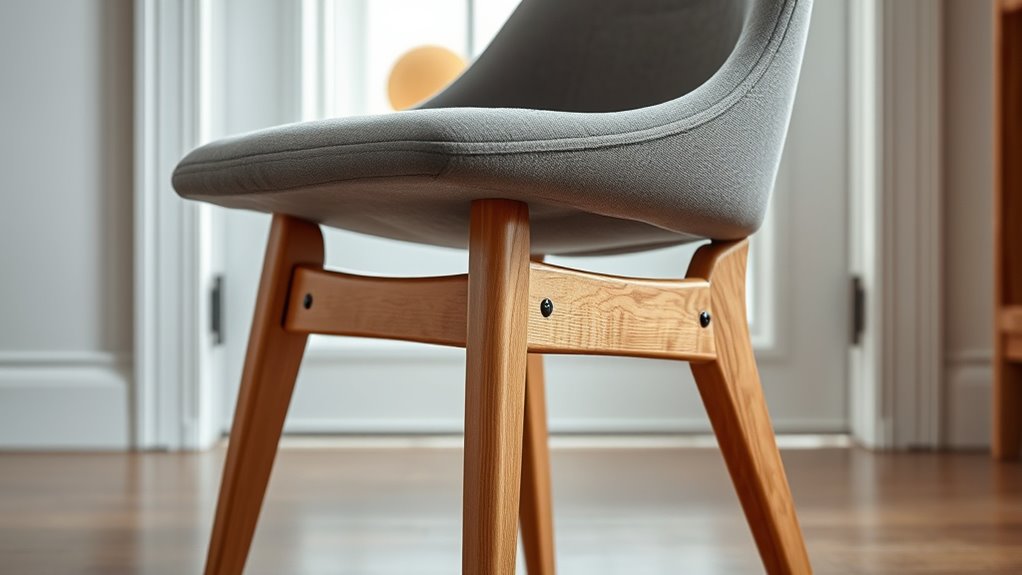
Understanding standard chair sizes and their variations is essential for guaranteeing both comfort and safety. When choosing a chair, consider its seat height, typically ranging from 16 to 20 inches, which affects ease of getting in and out. An ergonomic design prioritizes proper support, reducing strain and increasing comfort. Your chair cushion plays a crucial role in this by providing extra padding, especially if the seat is hard or firm. Different chairs are designed for various uses—dining chairs are usually lower, while office chairs are adjustable for ideal posture. Keep in mind that variations in size and design can impact your ability to fit through doorways or move comfortably. Selecting the right size ensures you avoid discomfort and potential safety hazards.
Measuring Doorway Dimensions Accurately
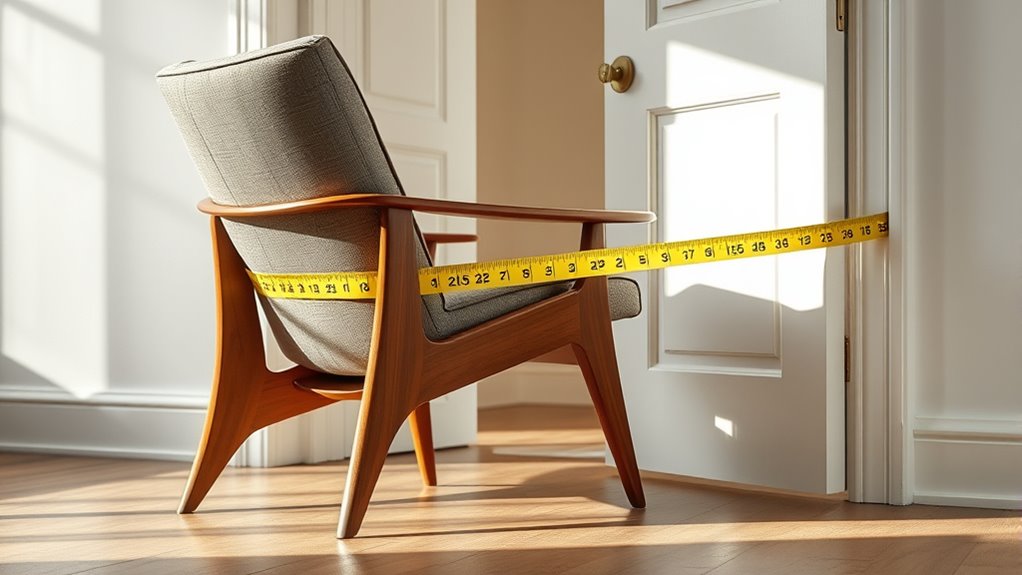
To measure your doorway accurately, you’ll need a tape measure or ruler. Make sure to use proper measuring techniques, like checking both the width and height at multiple points, to get precise results. Knowing common doorway sizes helps you determine if your space fits standard or custom furniture. Additionally, understanding typical dimensions of doorways can assist in planning for home theater projectors placement and setup.
Tools Needed for Measurement
Accurately measuring doorway dimensions requires the right tools to guarantee precision and ease. A sturdy tape measure is essential, providing material durability for repeated use and ensuring accurate length readings. A laser distance measurer is a great addition, offering quick, precise measurements with minimal effort. A sturdy, level helps confirm your measurements are perfectly vertical or horizontal, aiding in aesthetic appeal by aligning doors and furniture seamlessly. A notepad or digital device to record measurements keeps your data organized, preventing errors. For rough estimates or quick checks, a ruler or measuring stick can be handy. Using quality tools not only improves measurement accuracy but also ensures your tools last longer, maintaining their material durability and reliable performance for future projects. Incorporating accurate measurement techniques can significantly improve your overall results and help you avoid costly mistakes.
Measuring Techniques and Tips
When measuring doorway dimensions, it’s crucial to use consistent techniques to guarantee accuracy. Start by measuring the width and height at multiple points to account for any irregularities or wall imperfections. Use a reliable tape measure, keeping it straight and taut for precise readings. Take note of the doorway’s frame and consider fabric selection if you’ll hang curtains or coverings, as this affects clearance space. When planning, think about aesthetic considerations; choose measurements that complement your overall decor and style. Double-check your measurements before making any cuts or purchases. Accurate measurements help prevent fitting issues and ensure safe passage. Remember, consistency in your approach minimizes errors and streamlines the process of selecting or modifying doorways to suit your needs. Additionally, understanding the Unique and Wicked Planters options can inspire creative ways to decorate your doorway entrances with stylish plant displays.
Common Doorway Sizes
Understanding common doorway sizes is essential for ensuring your spaces are functional and accessible. Standard door widths usually range from 28 to 36 inches, with heights around 80 inches. To accommodate adjusting furniture or wheelchair compatibility, measure your doorways carefully. Keep in mind that wider openings, like 36 inches, make it easier to pass larger furniture or mobility aids. When measuring, check both the width and height, considering any trim or molding that might affect clearance. If your doorway isn’t standard, consider modifications to improve accessibility. Accurate measurements help you select furniture that fits comfortably and ensure doorways can support wheelchair passage without issues. Properly sizing your doorways enhances safety and usability for everyone in your space. Additionally, understanding doorway dimensions can help you select appropriate products and plan for future modifications.
Key Factors Affecting Chair Passage
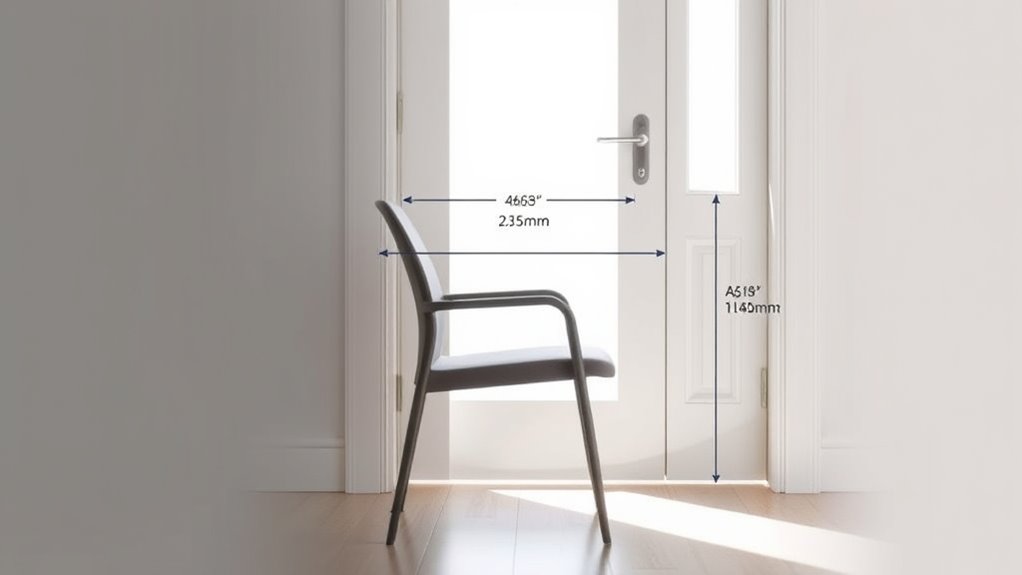
To guarantee your chair can pass through doorways smoothly, you need to take into account several key factors. These include the width of the door frame, the dimensions of the chair legs, and the clearance space around obstacles. Paying attention to these details helps prevent fitting issues and ensures safe passage. Additionally, considering customized planters designed for specific environments can enhance overall space management.
Door Frame Widths
The width of a door frame plays a crucial role in ensuring that chairs can pass through safely and easily. Adequate door frame widths are essential to meet clearance requirements, preventing damage to the chair or doorway. Standard doorways typically measure at least 32 inches, providing enough space for most chairs to pass without difficulty. However, wider door frames, around 36 inches, are recommended for larger or wheelchair-accessible chairs, ensuring smooth movement. When considering door frame widths, always account for the chair’s dimensions and any additional clearance needed for easy passage. Ensuring proper measurements helps avoid obstructions and makes your space safer and more accessible. Properly sized doorways not only facilitate safe passage but also reduce the risk of accidents or damage. Self Watering Plant Pots are designed with specific dimensions to optimize plant health and watering efficiency, which underscores the importance of accurate measurements in various applications.
Chair Leg Dimensions
Chair leg dimensions are a critical factor that directly impacts how easily a chair can pass through doorways. The key measurements to contemplate are:
- Chair leg height – taller legs increase overall height, potentially causing clearance issues.
- Leg thickness – thicker legs reduce the available space, making passage more difficult.
- Leg shape – rounded or tapered legs often fit better than bulky, square ones.
- Position of legs – legs positioned closer to the edges provide more clearance, easing movement.
Adding to this, considering the environmental impact of furniture design can help in selecting chairs that are easier to move and less likely to cause damage to surroundings.
Obstacle Clearance Space
When maneuvering through doorways, guaranteeing there’s enough obstacle clearance space is essential for smooth passage. You need at least 36 inches of clearance to accommodate wheelchairs and mobility aids comfortably. This space allows for easy turning and reduces the risk of accidents. Proper ramp installation can improve obstacle clearance, especially on uneven surfaces or steps, making access safer for wheelchair users. Additionally, selecting appropriate wheelchair accessories, like adjustable armrests or footrests, can help optimize space and prevent obstructions. Keep in mind that clutter or tight doorways reduce clearance, making passage difficult. Regularly checking and maintaining clear paths ensures safe, effortless movement through doorways, preventing injuries and easing the transition for anyone with mobility challenges. Incorporating green design principles into building modifications can further enhance accessibility and promote sustainable, inclusive environments.
Strategies for Navigating Tight Spaces

Managing tight spaces requires careful planning and awareness of your chair’s dimensions. To navigate these areas effectively, consider these strategies:
Navigating tight spaces? Assess your chair size and plan your path for smooth, snag-free movement.
- Assess your chair’s size, including its width, height, and chair upholstery, to determine if it fits comfortably through narrow doorways.
- Adjust your approach by angling the chair or turning it sideways to reduce the space needed.
- Use ergonomic design features like adjustable arms or reclining options to make maneuvering easier.
- Plan your path ahead, visualizing the movement to avoid sudden pivots or stops that can cause snags or damage.
- Be mindful of your chair’s shelf life and condition, as wear and tear can affect maneuverability and safety.
Staying aware of your chair’s measurements and incorporating these tactics helps prevent accidents while ensuring smooth navigation through tight spaces.
Tools and Techniques for Safe Moving
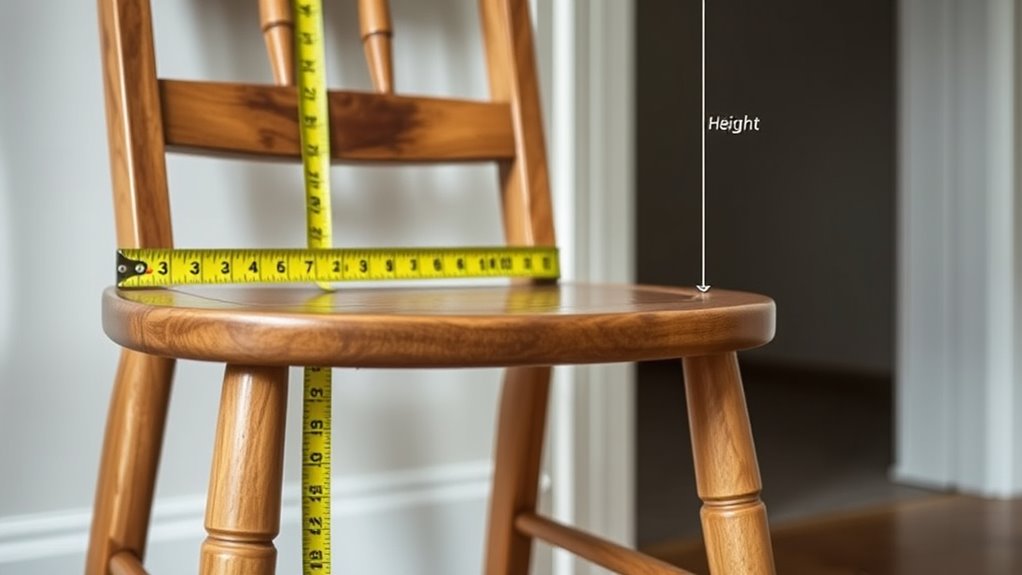
Using the right tools and techniques can make moving your chair safer and more efficient. When performing furniture rearrangement, start with sliders or furniture dollies to reduce strain and prevent damage to floors. These tools help you lift and slide heavy or bulky chairs smoothly. Additionally, applying ergonomic adjustments, like proper lifting techniques and maintaining a neutral spine, minimizes injury risk. Use straps or moving belts to secure the chair during transit, ensuring stability. Before moving, measure doorways and pathways to confirm clearance, and consider disassembling parts if possible. Always lift with your legs, not your back, and communicate clearly with others assisting you. Implementing proper safety measures can further reduce the risk of accidents during moving. These tools and techniques streamline furniture rearrangement, making the process safer and less stressful.
Common Obstacles and How to Overcome Them
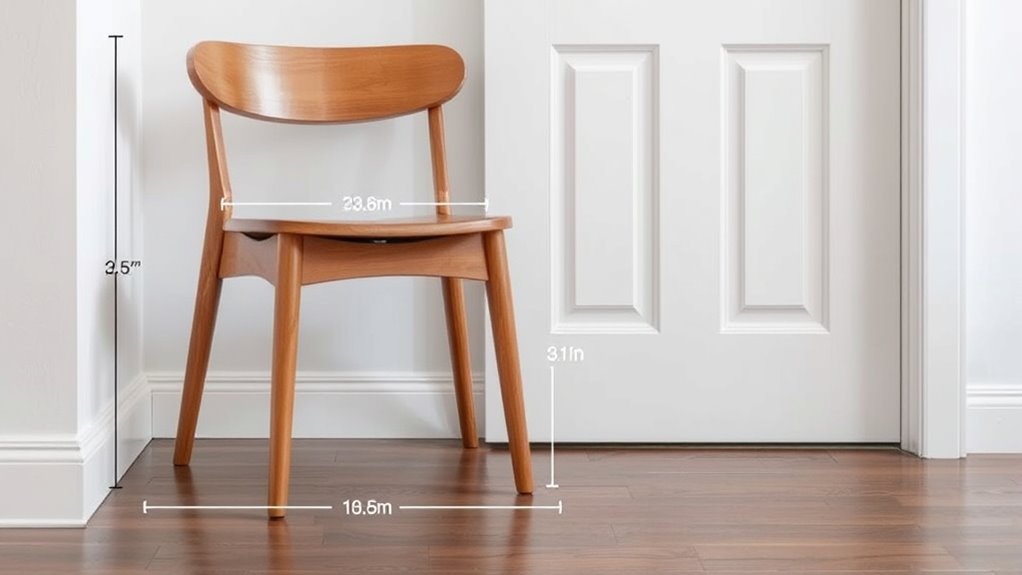
Obstacles such as narrow doorways, tight corners, and uneven flooring can make moving chairs challenging. To overcome these issues, consider these steps:
- Measure doorways and thresholds beforehand to identify potential problems.
- Remove or disassemble parts of the chair if possible, making it easier to pass through narrow spaces.
- Use sliders or dollies designed for uneven thresholds to navigate tricky surfaces smoothly.
- Plan your route carefully, choosing wider paths or adjusting furniture orientation to avoid tight corners.
Tips for Preventing Damage and Injuries
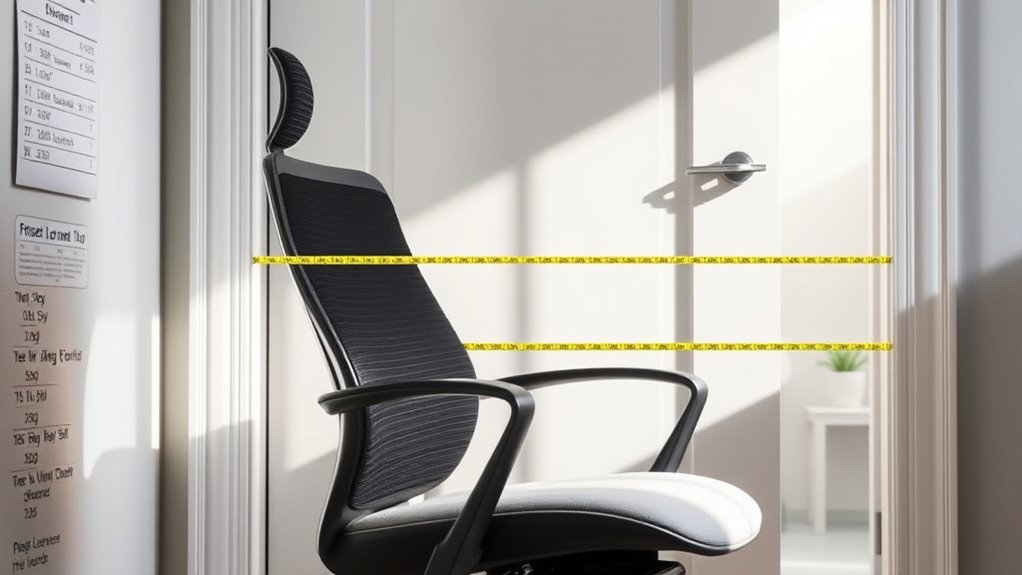
To prevent damage to your furniture and injuries during moves, it’s essential to stay proactive and attentive throughout the process. Prioritize evaluating the chair’s comfort and aesthetic design before moving it, ensuring it’s stable and secure. Use proper lifting techniques to avoid strain, and consider disassembling larger chairs to make transport easier. Protect delicate parts with padding or blankets to prevent scratches or dents, especially if the chair has an intricate aesthetic design. Measure doorways and hallways beforehand to ensure smooth passage. Clear pathways to avoid tripping hazards, and communicate clearly with helpers. By paying attention to these details, you reduce the risk of damage and injuries, keeping your furniture and yourself safe during every move.
Frequently Asked Questions
How Do Seasonal Changes Affect Door and Chair Dimensions?
Seasonal changes affect door and chair dimensions through temperature contraction and seasonal expansion. As temperatures rise, materials like wood and metal expand slightly, making doors and chairs a bit larger. Conversely, in colder weather, they contract, which can cause tight fits or difficulty opening doors. You should regularly check measurements during seasonal shifts to guarantee proper fit and safety, especially for older or sensitive materials prone to these natural dimensional changes.
Are There Age-Specific Safety Considerations for Chair and Doorway Sizes?
Think of it like the story of Goldilocks—what’s just right for each age? You should adapt chair and doorway sizes with age-specific safety considerations in mind. Childproofing measures and ergonomic design become essential, especially for young children or seniors. Smaller, lower chairs and wider doorways help prevent accidents, ensuring comfort and safety. Regularly reassess these dimensions as needs change, keeping every age group secure and comfortable in your space.
What Legal Standards Exist for Doorway Widths and Chair Safety?
You need to guarantee your doorways and chairs meet legal standards like ADA compliance and building codes. These regulations specify minimum doorway widths—generally 32 inches for accessibility—and require chairs to support weight and stability standards. By adhering to these standards, you guarantee safety and accessibility for everyone, including those with disabilities. Always check local building codes, as they may have additional or specific requirements you must follow.
How Does Furniture Style Impact Its Size and Maneuverability?
You notice that furniture style considerably impacts its size and maneuverability. With ergonomic design, chairs tend to be more compact and easier to move, enhancing safety and comfort. However, if you prefer aesthetic preferences like ornate or bulky furniture, expect larger sizes that might make steering doorways more challenging. Balancing style with practicality helps you choose furniture that suits your space while maintaining safe, easy maneuverability.
Can Smart Technology Assist in Measuring and Navigating Tight Spaces?
Smart technology acts like a helpful guide, making tight spaces less of a maze. Voice-activated measurements let you quickly get precise dimensions, so you know if furniture will fit. Augmented reality navigation overlays virtual pathways, helping you maneuver through doorways and around obstacles with confidence. With these tools, you gain a clearer picture of your space, turning what once felt like a puzzle into a manageable, even enjoyable, task.
Conclusion
By understanding chair sizes and doorway measurements, you can navigate tight spaces with confidence. Think of it as fitting a puzzle piece perfectly—every measurement must align. Use the right tools and techniques to prevent mishaps, ensuring your move is smooth and safe. With a little planning, you’ll turn potential obstacles into opportunities for a hassle-free passage, making your space feel like a well-oiled machine rather than a maze of challenges.
